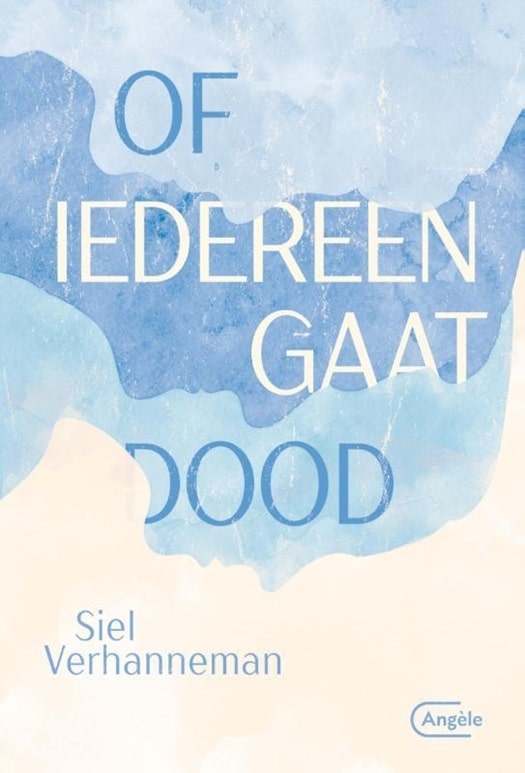‘Of iedereen gaat dood’ by Siel Verhanneman: Lives That Never Come Apart Again
Of iedereen gaat dood (Or else everyone dies) centres on the visits of the main character, pessimistic and neurotic Lander, to a therapist called Saskia. But who needs help most, and who is helping who? These are the central questions in this often-poignant debut novel from Siel Verhanneman.
Verhanneman (b. 1989), who hails from Kortrijk, has already gained recognition as a poet. She became known for her poetry via Instagram, where she has some 5,500 followers. She has already published two collections Als ik stil ben heb ik een bos in mijn hoofd (If I’m quiet, there’s a forest in my head) and Zo scherp je kon er ook niet geweest zijn (So vivid, one could also not have been there). In these, she displayed both a rich imagination and an original use of language, which we see again in her debut Of iedereen gaat dood (Or else everyone dies).
 Instagram poems by Siel Verhanneman
Instagram poems by Siel VerhannemanA therapy novel, that’s how we could call this debut. But it is much more than that. At the start we meet Saskia, a psychologist with a very lively imagination, who is just going back to work after a six-month break.
Sometimes Saskia can feel ashamed, when she lets herself flow away with her thoughts again. If, as a patient, she was to end up on her own mint green velvet sofa, she could give herself quite some tips on how to deal with this tendency, advice on how to rein in her fantasies. She might even fathom where those dream images come from, descended as she is from a muddled, incoherent family.
 Siel Verhanneman
Siel VerhannemanGoing back to work, Saskia is musing about those Mondays when Lander still came by. At first, she doesn’t really get a good sense of him. He seems to have stepped out of an advert for perfume: a picture of a boy with beautiful, full lips, high cheekbones, tousled curls above clean-shaven cheeks and a light, lazy glance.
He was only there because his grandmother insisted on it, he said, he himself didn’t think he needed therapy. Lander emerges as a lively storyteller, who doesn’t give away much of his true feelings. Saskia hangs on to his every word, it is he who determines the pace and content of their conversations, although occasionally Saskia does try to guide him in a certain direction.
According to Saskia, Lander is suspended between two states, too much or too little reality. Of course, that is similar to her own rich imagination. That’s where they cross paths. The subject of family is a delicate one for Lander, too. If it comes up, Lander sometimes can’t stop talking. Or he clams up completely.
After several chapters in which Saskia tells her story, suddenly the perspective tilts and the reader is placed inside Lander’s head. This is cleverly done: the change of style is such that after only a few sentences it is clear someone else is speaking.
Lander is a strong character. He narrates in short, taut sentences; devoid of emotion, but no less poignant for it. He dryly recounts his compulsive neuroses, how he distinguishes between safe and unsafe places, how he handles good and bad days. His style is sparse, pointed. While on the contrary Saskia’s thoughts take over the entire bandwidth of her attention.

That a sensual connection is slowly but steadily emerging between Saskia and Lander may not seem as a surprise, but the way that it happens is. Verhanneman cleverly unravels each character’s thoughts, thoughts in which the pair encounter and reject one other. In the rest of the novel, these two perspectives continually alternate. The story moves forward apace, yet the secrets of Lander and Saskia are revealed little by little.
Verhanneman unloads their story in subtle fragments that cannot fail to move the reader. Saskia and Lander’s thoughts tear at the frayed edges of the soul. This story is about loneliness; about not being understood; about going slowly mad; about emptiness and craving, for love, or at least some human warmth. Do they find this with each other, or not at all? Does Saskia gain more from Lander’s tale, upon which she can unleash her imagination, than Lander benefits from Saskia’s therapeutic questions and suggestions?
With less and less patience, reflected in ever shorter chapters, Verhanneman speeds to the story’s climax. It is a pressing, poignant conclusion of two lives that can never be seen separately again.
Excerpt from ‘Of iedereen gaat dood’, as translated by Paul Vincent
Most clients choose one fixed spot during their first session and seldom stray from it. People come in and for appearance’s sake, Saskia waits until they have chosen their spot. Everyone does it in their own way in that first minute. Many of them immediately shake hands. Geeraart invariably lays his free hand on the two that are touching. Josephine always looks one straight in the eye and Carmen only shakes hands after she has sat down. They all have their own ritual, which is repeated again and again. With Lander it was different. He came straight in and sat down. To begin with she was embarrassed that her handshake hung in the air unanswered.
From their first session on Lander always chose a different place. He was one of the few clients who alternated between the available chairs. There are three of them: two next to each other, for when a partner or a parent is invited in during a session, and one opposite them, for her. Lander did not alternate between the two chairs intended for her clients. No, he alternated between one of the clients’ chairs and hers. She does not know what happens with other therapists, but she likes to have her own fixed spot in the room. That is her habitat, her chair from which she thinks along with her clients and listens to them. For most clients that is immediately clear, she makes sure that something is lying there to demarcate her territory: a scarf, a biro, a bag leaning against it. But Lander ignored the objects and occasionally sat there and she, she was dumbfounded by his cheek. She challenged him indirectly about it by asking by asking, apparently spontaneously, whether he liked that alternation.
‘I sit down wherever my body wants,’ he said, nonchalantly shrugging his shoulders, as if they were momentarily suspended in mid-air in slow motion and landed back even more slowly below his neck.
She sits down, because as well as her legs the rest of her body is beginning to lose sensation. There is an annoying tingling on her skin and she tries to find a comparison. She gets no further than a colony of ants. When she was in primary school, she often spent her time making up metaphors: father’s jaws hang on his face like two scales, father is a fish. The hot water pricks as if someone is covering her all over with tiny tattoos using fine needles. The black spots on the baker’s nose are like round rafts on skin-coloured water.
But no simile was good enough to describe the sour corners of mother’s mouth. All she could do, was attach two small weights to them in her mind. Then the cause of her mood could not lie with Saskia. Or with anyone.
Siel Verhanneman, Of iedereen gaat dood, Angèle, Antwerpen, 2019, 208 pp.












